Anoop,
This has really helped me so much…..I used to work on my abs hard….but the way you have suggested here is working great.
Thank You.
Ashok

February 22 2009
In order to understand your ab muscles better, you have to understand your hip flexor muscles. The hip flexors attaches to your spine, pelvis, and your inner thigh bone (collectively called Illiapsoas). From the attachments of the muscles (shown in the picture), you can easily see that flexing the Illiapsaos will bend your torso or raise your legs.
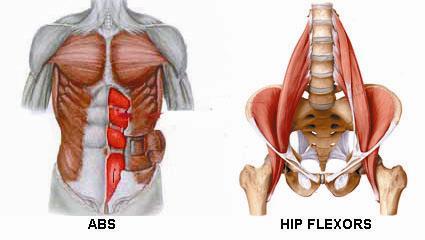
The ab muscle,on the other hand, is attached to the sternum and the pelvis. Thus flexing the ab muscle just rounds the low back.
The first picture shows a conventional sit up. The hip flexors is activated once your torso go past 30 degree of flexion as shown in the left picture. The picture on the right shows the proper form for a crunch (see the rounding of the low back).
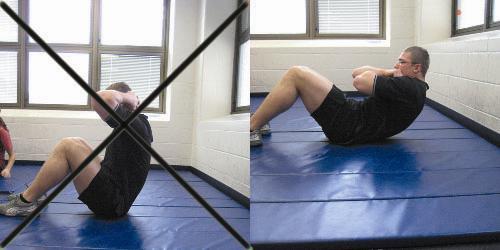
The pictures below show a common mistake when doing leg raises. If you are not conscious of rounding you low back, leg raises is a great exercise for your hip flexors. You will often see low backs coming off the pad because of the pull of the hip flexors on the spine.
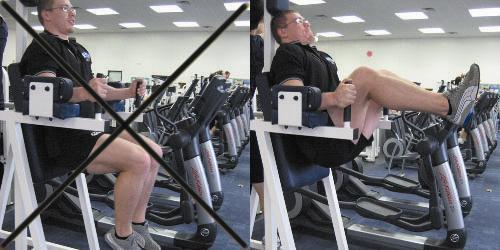
You have to intentionally round your low back to really work your abs when doing leg raises.
The below exercise is one of the most popular exercise in the gym. Unfortunately, this is another great example of how to engage your hip flexors in your ab exercise. Anchoring your feet or having someone stand on your feet are just different ways to use your hip flexors in your ab exercises.
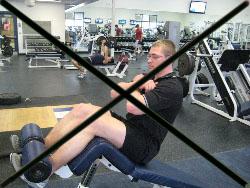
The techniques below help to inhibit the hip flexors or/and activate your abs better.
The first method is based on the principle of Active Insufficiency. Once a muscle has shortened, it becomes “actively insufficient” (or the muscle is unable to contract further). By keeping your legs wide apart, you have already contracted your hip flexors (llliopsoas)and hence they are unable to aid in hip flexion anymore.
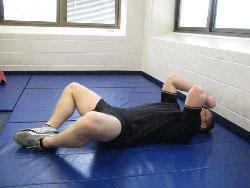
The reason why the knees are bent 90 degree when doing a sit up or a crunch is to inhibit your rectus femoris muscle (also aids in hip flexion) based on the principle of Active Insufficiency.
The second method (also known as the Janda situp) is based on the principle of Reciprocal Inhibition. By pulling on your heels (as shown in the pic), you are contracting your glutes and hamstring, which relaxes you hip flexors and thus isolates your abs better.
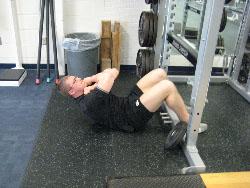
The third method involves squeezing a ball between your knees as you crunch. This helps to isolate your abs as both the abs and adductors have a common insertion point.
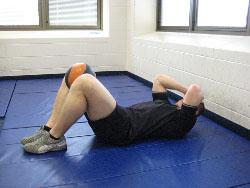
Picture Courtesy: Braden Sowle
Anoop,
This has really helped me so much…..I used to work on my abs hard….but the way you have suggested here is working great.
Thank You.
Ashok
Anoop | Sun March 08, 2009
Hi Ashok,
Glad to hear it’s working. Thanks for the comment.
I love working my hip flexors, and apparently girls love seeing that type of definition. All the more reason to start sagging my pants while going commando 😉
Hi Anoop - If there was such a thing - I would love to have you as a mentor. I appreciate your dedication to your work. Thanks. I’m new to your site and will continue to return for valuable information. I’m an ACE PT for the “non” athlete and have constant questions about properly training my senior or joint restricted clients (ie: the regular people). - PS I have extremely tight hip flexors and can’t seem to deactivate them. I have no glutes and my abs seem weak for the amount of work I do. My hip flexors do all the work and never rest - even to enjoy a proper stretch. I understand what’s happening but I don’t know what to do about it. I over thinking it! PSS - I have low back pain and SI pain due to this issue. Patty - your new student
Anoop | Fri August 21, 2009
Hi Patty,
Thanks for the comment.
I would say stretch your hip flexors before you work your abs. This way you will be toning down the hip flexors. And use the techniques above to minimize the involvement of the hip flexors further.
And include exercises which recruit your glutes more like deadlift, stifff legged or romanian deadlift.
I am guessing you might have a lordotic posture which is usually caused by tight hip flexors and weak abs.
And hope you joined the forum.
Jesse T | Tue September 08, 2009
Wow. This is 100% more effective than my old ways of doing abs. Now that I understand what’s actually going on, it’s easy to target the abs.
Thanks a lot,
Jesse
Thanks for the article. Because I never realized I was doing sit up wrongly. Not only me, but most book also get it wrong.
pattybirk | Sun October 18, 2009
Hi
Am I able to use your articles? I’m a guest writer for a local newspaper every other month concerning a fitness topic. I would love to use your articles in the body of my column. thoughts!
Anoop | Sun October 18, 2009
Hi Patty,
I would love to have my articles, but only if it has my name and my website name. I hope that’s reasonable
Thanks for asking.And I hope you read the pain thread in the forum
pattybirk | Sun October 18, 2009
thanks - and yes,I will absolutely include your name and website.
I will check out the pain thread as my SI and lower back is getting worse, making it hard to workout (and I’m a personal trainer and grp exercises coach - ouch). Definite lower cross syndrome with a curve in the spine to make it all bad.
Anoop | Wed October 21, 2009
Hi Patty,
Let me when it goes to print.
Also pain has very little to do with posture. Read this article. I wrote it: http://www.mindandmuscle.net/articles/a_balachandran/posture
pattybirk | Mon December 14, 2009
Hi Anoop,
I read your article on Posture. Excellent! Especially the science to back it. But now what???? What do I do. I work with clients (golfers mostly) that are told posture is key to their game. They stretch tight muscles and strengthen weak. TPI (golf fitness - Gray, Dr Rose and so on)....., has me do a full assessment to see where they have dysfunction and muscle imbalances. Now what??? Do we just train per ACE exercise guidelines and avoid this relationship? A lot of information is out there and everyone really likes it. Now I tell them - never mind….. I need your guidance. Patty
Anoop | Tue December 15, 2009
Hi Patty,
Thanks!! Most of the references got deleted when they redid the whole site. I think someone in another forum has a pdf copy.
My article was mainly about posture and pain. And I doubt there will be much performance improvement with fixing posture. And that is if you can fix someone’s posture.
And even if you fix posture, there is no guarantee that they are goona change their swing which they have been doing it for so many years.
Movement re-educatiomn might be helpful and that’s where Gray Cook and Gary Gray are talking about.
And you have to understand that these concepts are not as black and white as most of these fitness guru’s try to make. There is a lot of gray areas. So always take these recommendations with a grain of salt
And if you wanna learn more about posture, read Kendall’s Posture book.She is the one who started the posture fixing and is considered to be the bible of postural analysis. Everyone just copies from it. Just so that you know, she didn’t even have one single reference to back what she said in her book.
Power Plate | Sat March 06, 2010
Besides crunches, I am looking for an ab routine to do from my home. I do not have any medicine ball or anything. What are some good home ab exercises I can do regularly? How many sets and reps with each exercise? Thanks.Power Plate
© 2008 - 2025 | Exercise Biology. All rights reserved.